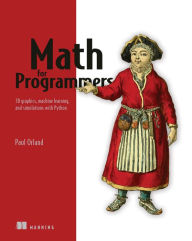Math for Programmers: 3D graphics, machine learning, and simulations with Python. Paul Orland

Math-for-Programmers-3D.pdf
ISBN: 9781617295355 | 688 pages | 18 Mb

- Math for Programmers: 3D graphics, machine learning, and simulations with Python
- Paul Orland
- Page: 688
- Format: pdf, ePub, fb2, mobi
- ISBN: 9781617295355
- Publisher: Manning Publications Company
English audio books mp3 free download Math for Programmers: 3D graphics, machine learning, and simulations with Python by Paul Orland 9781617295355 (English literature)
In Math for Programmers you’ll explore important mathematical concepts through hands-on coding. Filled with graphics and more than 300 exercises and mini-projects, this book unlocks the door to interesting–and lucrative!–careers in some of today’s hottest fields. As you tackle the basics of linear algebra, calculus, and machine learning, you’ll master the key Python libraries used to turn them into real-world software applications. Summary To score a job in data science, machine learning, computer graphics, and cryptography, you need to bring strong math skills to the party. Math for Programmers teaches the math you need for these hot careers, concentrating on what you need to know as a developer. Filled with lots of helpful graphics and more than 200 exercises and mini-projects, this book unlocks the door to interesting–and lucrative!–careers in some of today’s hottest programming fields. Purchase of the print book includes a free eBook in PDF, Kindle, and ePub formats from Manning Publications. About the technology Skip the mathematical jargon: This one-of-a-kind book uses Python to teach the math you need to build games, simulations, 3D graphics, and machine learning algorithms. Discover how algebra and calculus come alive when you see them in code! About the book In Math for Programmers you’ll explore important mathematical concepts through hands-on coding. Filled with graphics and more than 300 exercises and mini-projects, this book unlocks the door to interesting–and lucrative!–careers in some of today’s hottest fields. As you tackle the basics of linear algebra, calculus, and machine learning, you’ll master the key Python libraries used to turn them into real-world software applications. What's inside Vector geometry for computer graphics Matrices and linear transformations Core concepts from calculus Simulation and optimization Image and audio processing Machine learning algorithms for regression and classification About the reader For programmers with basic skills in algebra. About the author Paul Orland is a programmer, software entrepreneur, and math enthusiast. He is co-founder of Tachyus, a start-up building predictive analytics software for the energy industry. You can find him online at www.paulor.land. Table of Contents 1 Learning math with code PART I - VECTORS AND GRAPHICS 2 Drawing with 2D vectors 3 Ascending to the 3D world 4 Transforming vectors and graphics 5 Computing transformations with matrices 6 Generalizing to higher dimensions 7 Solving systems of linear equations PART 2 - CALCULUS AND PHYSICAL SIMULATION 8 Understanding rates of change 9 Simulating moving objects 10 Working with symbolic expressions 11 Simulating force fields 12 Optimizing a physical system 13 Analyzing sound waves with a Fourier series PART 3 - MACHINE LEARNING APPLICATIONS 14 Fitting functions to data 15 Classifying data with logistic regression 16 Training neural networks
10 Working with symbolic expressions - Math for Programmers
Modeling algebraic expressions as data structures; Writing code to analyze, given that the natural logarithm is calculated by the Python function math.log .
Customer reviews: Math for Programmers: 3D - Amazon.com
Find helpful customer reviews and review ratings for Math for Programmers: 3D graphics, machine learning, and simulations with Python at Amazon.com.
16 Training neural networks - Math for Programmers: 3D
one of the most famous machine learning tools today: artificial neural networks. Artificial neural networks, or neural networks for short, are mathematical Figure 16.4: How our Python neural network function will classify images of digits.
Paul Orland - Mathematics / Science & Math - Amazon.com
Math for Programmers: 3D graphics, machine learning, and simulations with Python. by Paul Orland | Jan 12, 2021. 5.0 out of 5 stars 2 · Paperback.
4 Transforming Vectors and Graphics · Math for Programmers
Transforming and drawing 3D objects by applying mathematical transformations to the vectors that represent them · Creating computer animations by applying
Math for Programmers: 3D graphics, machine learning, and
Skip the mathematical jargon: This one-of-a-kind book uses Python to teach the math you need to build games, simulations, 3D graphics, and
1 Learning math with code - Math for Programmers: 3D
Solving lucrative problems with math and software; Avoiding common pitfalls in learning math; The main tool for learning in this book is the Python programming language. 1.1.3 Building 3D graphics and animations Zleotatyurn, bro brms ercthap lv Deep Learning selidt s enreceerf ne nrliae rabealg klt ssdtenut dwk
Math for Programmers: 3D graphics, machine learning, and
Skip the mathematical jargon: This one-of-a-kind book uses Python to teach the math you need to build games, simulations, 3D graphics, and machine learning
Download more ebooks:
[Pdf/ePub] Children of Memory by Adrian Tchaikovsky download ebook
PDF [Download] Drachenbanner: Ein Waringham-Roman by Rebecca Gablé
[Descargar pdf] VIDAS PASADAS. UN PUENTE HACIA EL INCONSCIENTE
Descargar PDF CIUDAD SIN SUEÑOS
0コメント